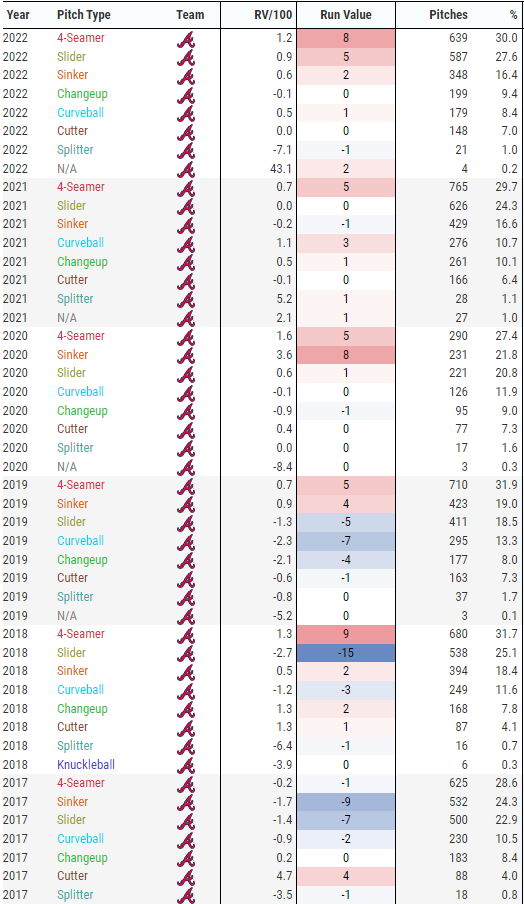Dansby Swanson’s clout has always been palpable. Due to an excellent collegiate career that culminated with a 1.046 OPS and an NCAA championship MVP at Vanderbilt, it was no surprise that Swanson was unanimously earmarked as the #1 overall pick in the 2015 draft. It seemed as though he was destined for immediate greatness in major league baseball.
Dansby’s minor league career began as anticipated with a .289/.394/.482 line through his first 22 games with the Diamondbacks. Soon after, Swanson would be traded to his hometown Atlanta Braves. It felt as though the stars were aligning for an immediate impact player to make his presence known. But as it turns out, being a major league baseball player is hard. Dansby’s road to prominence has been more systematic than he originally intended.
Early Career Standard Stats
In Swanson’s first full year in the majors, he slashed .232/.312/.324 with a 63 WRC+ and a -0.2 fWAR. Additionally, his offensive woes were matched by league-average defensive metrics. In short, he was very much a below-average major league shortstop.
In 2018, Dansby improved across the board – though not substantially. His homer numbers doubled, and he stole 7 more bases than the previous year. Resultantly, his slugging percentage approached .400 and his WRC+ jumped to 79. In addition to the extra power, Swanson also improved his defense at shortstop. While these improvements were a step in the positive direction, he remained largely average with a 1.4 fWAR.
Through two seasons in the majors, the prodigy that was to be “Superstar Swanson” had not come to fruition. However, there is a mental side to baseball that is equally as important to develop and, at times, intangible. In the background, Dansby worked diligently to become a leader on and off the field and live up to the ability that he knew he possessed. He focused on his mechanics on both sides of the ball and knew the results would follow if he continued to work on his craft.
And, sure enough… the results came. He followed his 2018 campaign with 4 consecutive seasons of increased production. Dansby started to put the ball in play far more frequently and showed an evolving power tool. Also, Swanson’s defense steadily improved to the point where he is now considered one of the best defensive shortstops in major league baseball. Over six seasons, Dansby went from a below-average hitter with average defense to a player who could finish the 2022 season with a nearly 7.0 fWAR.
For the 2021 season, a 7.0 fWAR would have tied with JUAN SOTO for second amongst all major league hitters!
fWAR also takes into account a player’s defensive metrics; while defense is extremely valuable to a baseball player’s career, let’s dig a bit deeper into his offense to try and determine how Swanson became so formidable.
Statcast Metrics
Dansby seemed to find something in the offseason between the 2018 and 2019 seasons. On the surface, Swanson wasn’t that different. He showed slightly improved slugging, but in general, his batting profile felt very similar when utilizing the “eye test” or traditional statistics. However, the advanced metrics showed that Dansby was hitting the ball much harder. In fact, his expected slugging percentage jumped over 100 points! Beyond that, Swanson’s exit velocity jumped nearly 2 MPH. Virtually every statcast power metric said, “Hey, this guy is doing something different.”
Though it happened before the 2019 season, it’s also worth noting that after his inaugural season in the majors, it seems as though Dansby bought into the launch angle trend. Between seasons 2017 and 2018, Swanson’s launch angle jumped nearly 6% and his home run total more than doubled.
Swanson decided that he was going to hit the ball harder and higher. Sounds simple enough, right? Well, it seemed to have worked for him.
Another distinguishable result of his swing change was the immediate jump in Dansby’s xwOBA. Up 70 points from his 2018 season and in addition to a 6% barrel rate increase and a 7.6% hardhit% increase, it’s not that surprising that he had more productive at-bats. Swanson has sustained the same level of performance (or better) from 2018 onward. As his statcast chart shows, most of his expected stats are in the same range. Dansby must like solid contact, though, as his hardhit% continues to increase with each passing year.
It’s one thing to say “I’m going to hit the ball harder.” It’s another thing to actually do it. Did Swanson approach at-bats fundamentally differently, or was his success a product of experience?
Pitch Type Adjustment
Dansby Swanson can hit anybody’s fastball at any location – this has been well-documented since his college days and is a mainstay in his offensive prowess. Early in Dansby’s career, however, he was victimized by breaking balls. As evidenced by his career 24.1% K rate, major league pitchers determined quite quickly that Swanson struggled to pick up a slider and make consistent contact on it in or out of the zone. Below Dansby’s year-by-year run value by pitch can be seen via Baseball Savant.

Dansby’s run value by pitch type showed a lot of negative values for breaking balls until he seemingly turned a corner in 2020. From there, Swanson showed a steady increase in run value for all pitches. This culminated with zero negative values and a massive jump in slider run value in 2022 that catapulted Dansby into the upper percentile for run value on sliders. In fact, Dansby went from nearly all blue (lower percentile) run values to nearly all red (upper percentile) run values for ALL pitches!
On the flip side, Swanson’s K% on sliders has increased through the years. The difference now, however, is that he chooses his pitches more wisely and when he gets his pitch, he hits it hard.
Final Thoughts
Even with these adjustments, Dansby still has a large quantity of “swing-and-miss” in his game and continues to prefer to get on base via hitting instead of walks. But if we know anything about Dansby, he’ll never stop working to improve.
Dansby Swanson took a hard look at himself in the mirror and decided to change for the better. He knew that he was more exceptional than what his early career showed. Much like we all strive to do in our respective lives, Swanson pinpointed his weaknesses and put forth the work to improve upon them. Combining that with his natural fastball-hitting ability and elite baseball IQ, it seems to be quite clear – the era of Dansby Swanson is upon us and likely isn’t going anywhere anytime soon.

